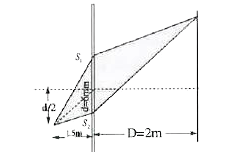A slit 5.0 cm wide is irradiated normally with microwaves of wavelength 1.0 cm. Then the angular spread of the central maximum on either side of the incident light is nearlySolution in Telugu
radian
5 radian
4 radian
6 radian
The correct Answer is:A
Step by step video, text & image solution for A slit 5.0 cm wide is irradiated normally with microwaves of wavelength 1.0 cm. Then the angular spread of the central maximum on either side of the incident light is nearly by Physics experts to help you in doubts & scoring excellent marks in Class 12 exams.
Updated on:21/07/2023Topper's Solved these Questions
- WAVE OPTICSBOOK - AAKASH SERIESCHAPTER - WAVE OPTICSEXERCISE - LECTURE SHEET Exercise - II DIFFRACTION (Level - I (Main) Level - II (Straight objective type questions)
8 Videos
- WAVE OPTICSBOOK - AAKASH SERIESCHAPTER - WAVE OPTICSEXERCISE - LECTURE SHEET Exercise - III POLARLISATION(Level - I (Main) (Straight objective Type questions))
9 Videos
- WAVE OPTICSBOOK - AAKASH SERIESCHAPTER - WAVE OPTICSEXERCISE - LECTURE SHEET (EXERCISE - I) (INTERFERENCE & YDSE) Level - II (ADVANCED) Level - II (straight objective Type Questions) Integer Type Questions
1 Videos
- WAVE MOTION AND SOUNDBOOK - AAKASH SERIESCHAPTER - WAVE MOTION AND SOUNDEXERCISE - PROBLEMS (LEVEL - II)
81 Videos
- WAVESBOOK - AAKASH SERIESCHAPTER - WAVESEXERCISE - EXERCISE-III (Doppler effect :)
15 Videos
Similar Questions
In a Fraunhoffer diffraction experiment at a single slit using light of wavelength 400 nm, the first minimum is formed at an angle of 30∘. Then the direction θ of the first secondary maximum is
View SolutionFrom brewster's law for polarisation, it follows that the angle polarisation depends upon
View SolutionIn the YDSE the monochromatic source of wavelength λ is placed at a distance d2 from the central axis (as shown in the figure), where d is the separation between two slits S1 and S2. Find the position of the central maxima. (Given d = 6 mm)

View SolutionA wave is described by the equation
y=(1.0mm)sinπ(x2.0cm−10.01s)
Find the time period and the wavelength.
View SolutionWhen a train is approaching the stationary observer, the apparent frequency of the whistle observed as 100 Hz, while when it has passed away from the observer with same speed, it is 50 Hz. Calculate the frequency of the whistle when the observer moves with the train (V = 330 m/s)
View SolutionA slit 5 cm wide when irradiated by waves of wavelength 10 mm results in the angular spread of the central maxima on either side of incident light by about :
View SolutionA slit 4.0 cm wide is irradiated with microwaves of 2.0 cm. Find the angular spread of central maximum assuming incidence normal to the plane of the slit.
View SolutionMicrowaves of frequency 24,000 MHz are incident normally on a rectengular on a rectangular slit of width 5 cm. Calculate the angular spread of the central maximum of the diffraction pattern of the slit.
View SolutionA slit 4.0 cm wide is irradiated with microwaves od wavelengths 2.0 cm. Find the angular spread of the central maximum, assuming incidence normal to the plane of the slit.
View SolutionA slit whose width is 5.0 cm is irradiated with microwaves of wavelength 3 cm. What is the angular spread of the central maximum? Assume normal incidence.
View SolutionA microwave of wavelength 2 cm falls normally on a narrow slit of width 5 cm. what is the angular width of central maximum on either side of it?
View SolutionA slit 4 cm wide is irradiated with microwaves of wavelength 2 cm. Find the angular spread of central maxima assuming incidence normal to the plane of the slit.
View SolutionA slit whose width is 5.0 cm is irradiated with microwaves of wavelength 2 cm. The angular spread of the central maximum ? (Assume that the incidence is along the normal to the plane of the slit) is
View SolutionA slit 5 cm wide is irradiated normally with microwaves of wavelength 1.0 cm. Then the angular instead of central maximum on either side of incident light is nearly
View SolutionA slit 5.0 cm wide is irradiated normally with microwaves 1.0 sm . Then the angular spread of the central maximum on either side of the incident light is nearly
View Solution
